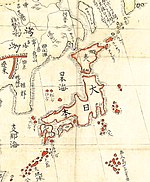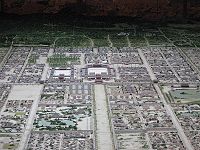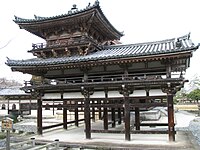Heian period Contents History | Timeline | Gallery | Related pages | References | Other websites | Navigation menueLibrary of Congress Country Studies, Japan"Nara and Heian Periods"History of Tendai BuddhismKoyosan Shingon BuddhismKobo DaishiAsian Historical ArchitectureByōdō-inHeian Period (794–1185)Heian period (AD 794-1185)Nara and Heian Periods (710-1185)adding to it
Periods in Japanese history
Japanese historygroupingHeian-kyōKyotoKamakura period![]() Heian period
Heian period
Heian period
Jump to navigation
Jump to search
| History of Japan | ||||||||||||||||||||||||||||||||||
|---|---|---|---|---|---|---|---|---|---|---|---|---|---|---|---|---|---|---|---|---|---|---|---|---|---|---|---|---|---|---|---|---|---|---|
 | ||||||||||||||||||||||||||||||||||
Periods
| ||||||||||||||||||||||||||||||||||
Topics
| ||||||||||||||||||||||||||||||||||
| ||||||||||||||||||||||||||||||||||
The Heian period (平安時代, Heian jidai) is a time in the Japanese history from 794 to 1185. This grouping of years is named after city of Heian-kyō, which is the early name of present day Kyoto.[1]
Contents
1 History
2 Timeline
3 Gallery
4 Related pages
5 References
6 Other websites
History |
The Heian period began in 794 when the capital of Japan was moved to Heian-kyō. It lasted until 1185, which is the beginning of the Kamakura period.[2]
In this period Kyoto was the center of Japanese culture. It was also in this period that the first known novel was published. Its author was a woman. Poetry was very popular in Heian-kyo at the time.
Timeline |
794: Emperor Kammu moves the capital to Heian-kyō.[3]
804: Saichō (also known as Dengyo Daishi) establishes the Tendai Buddhist sect in Japan.[4]
806: Kūkai (also known as Kōbō-Daishi) establishes the Shingon Bhuddist sect in Japan[5]
858: Reign of Emperor Seiwa begins; the power of the Fujiwara clan expands[6]
895: Sugawara Michizane persuades Emperor Uda to suspend Imperial embassies to China.[7]
1053: Byōdō-in temple near Kyōto is completed[8]
1087: Emperor Shirakawa abdicates and becomes a Buddhist monk, the beginning of the Insei system of Imperial government[9]
1185: Death of Emperor Antoku; Taira clan is defeated in the Gempei War[10]
Gallery |

Model of ancient Kyoto with Imperial Palace

South wing of the Phoenix Hall in the Byodo-In temple in Uji
Related pages |
- List of Japanese eras
References |
↑ Library of Congress Country Studies, Japan,"Nara and Heian Periods"; retrieved 2011-10-20.
↑ Nussbaum, Louis-Frédéric. (2002). "Heian-jidai" in Japan Encyclopedia, p. 302.
↑ Brown, Delmer M. (1979). Gukanshō, pp. 277-279.
↑ History of Tendai Buddhism; retrieved 2011-10-20.
↑ Koyosan Shingon Buddhism, Kobo Daishi; retrieved 2011-10-20.
↑ Titsingh, Isaac. (1834). Annales des empereurs du japon, pp. 115-121; Brown, pp. 286-288; Varley, H. Paul. (1980). Jinnō Shōtōki, pp. 166-17.
↑ Kitagawa, Hiroshi et al. (1975). The Tale of the Heike, p. 222.
↑ Asian Historical Architecture, Byōdō-in; retrieved 2011-10-20.
↑ Titsingh, p. 171; Brown, p. 316; Varley, p. 202.
↑ Kitagawa, p. 787; Titsingh, pp. 211-212.
Other websites |
![]() Media related to Heian period at Wikimedia Commons
Media related to Heian period at Wikimedia Commons
- Metropolitan Museum of Art, Heian Period (794–1185)
- British Museum, Heian period (AD 794-1185)
- Japan-guide.com, Nara and Heian Periods (710-1185)
Category:
- Periods in Japanese history
(RLQ=window.RLQ||[]).push(function()mw.config.set("wgPageParseReport":"limitreport":"cputime":"0.196","walltime":"0.284","ppvisitednodes":"value":813,"limit":1000000,"ppgeneratednodes":"value":0,"limit":1500000,"postexpandincludesize":"value":41075,"limit":2097152,"templateargumentsize":"value":2070,"limit":2097152,"expansiondepth":"value":12,"limit":40,"expensivefunctioncount":"value":0,"limit":500,"unstrip-depth":"value":0,"limit":20,"unstrip-size":"value":5255,"limit":5000000,"entityaccesscount":"value":1,"limit":400,"timingprofile":["100.00% 223.977 1 -total"," 46.14% 103.345 1 Template:History_of_Japan"," 43.59% 97.622 1 Template:Sidebar_with_collapsible_lists"," 20.18% 45.204 2 Template:Aligned_table"," 17.53% 39.270 1 Template:Nihongo"," 12.47% 27.941 1 Template:Commons_category-inline"," 12.19% 27.294 1 Template:Category_handler"," 11.31% 25.322 6 Template:Longitem"," 10.89% 24.402 1 Template:Sister-inline"," 9.02% 20.195 7 Template:Ublist"],"scribunto":"limitreport-timeusage":"value":"0.044","limit":"10.000","limitreport-memusage":"value":1374793,"limit":52428800,"cachereport":"origin":"mw1267","timestamp":"20190518133112","ttl":2592000,"transientcontent":false););"@context":"https://schema.org","@type":"Article","name":"Heian period","url":"https://simple.wikipedia.org/wiki/Heian_period","sameAs":"http://www.wikidata.org/entity/Q193292","mainEntity":"http://www.wikidata.org/entity/Q193292","author":"@type":"Organization","name":"Contributors to Wikimedia projects","publisher":"@type":"Organization","name":"Wikimedia Foundation, Inc.","logo":"@type":"ImageObject","url":"https://www.wikimedia.org/static/images/wmf-hor-googpub.png","datePublished":"2011-10-20T15:56:36Z","dateModified":"2018-09-09T00:41:25Z","image":"https://upload.wikimedia.org/wikipedia/commons/a/aa/KaiIchiranzu1806.jpg","headline":"last major division of classical Japanese history (794 to 1185), named after the capital city of Heian-kyu014d, or modern Kyu014dto"(RLQ=window.RLQ||[]).push(function()mw.config.set("wgBackendResponseTime":106,"wgHostname":"mw1250"););

